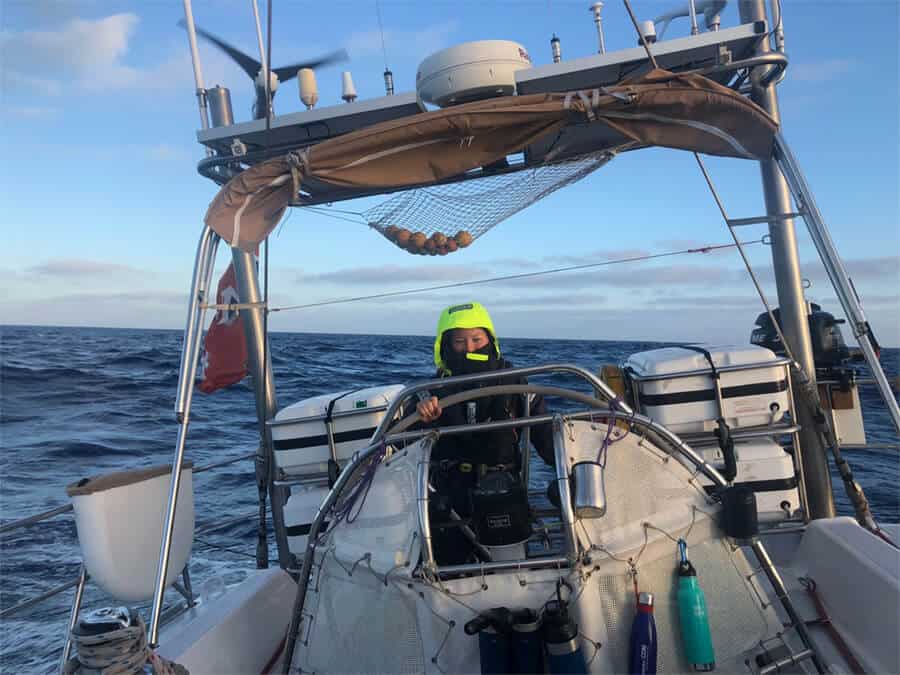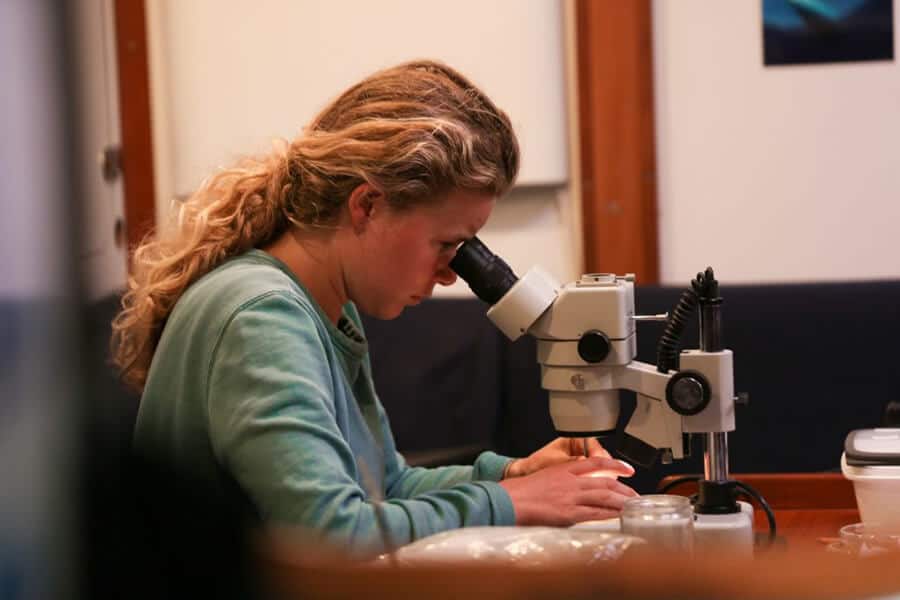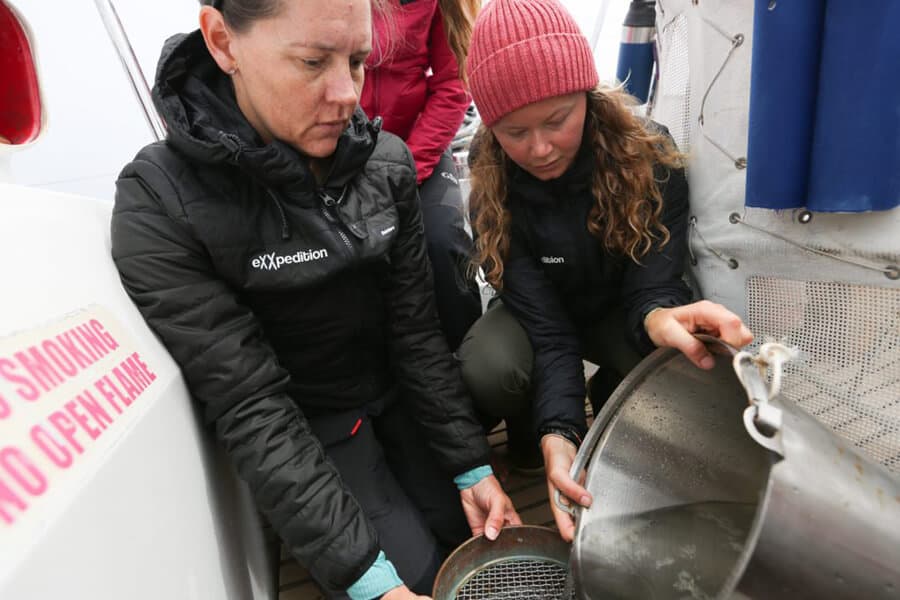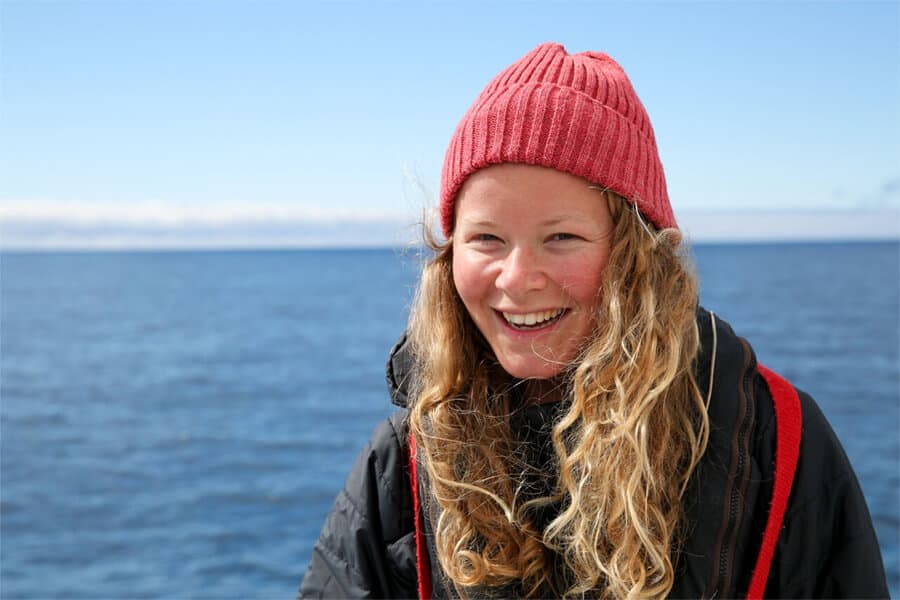Although her job is a serious science mixed with a fascination with marine life conservation, Dr. Emily Duncan (27) sees it as an exciting adventure too. This includes collecting samples while being hit by strong wind and waves at a 45-degree angle and spending a night on a beach with huge turtles. Her devotion led her from the rivers of India to crossing the cold waters of the Pacific and she won’t stop until all of us wake up – and face the facts.
Just 4 days after handing in her Ph.D. Emily Duncan flew to Hawaii to be the Head of Science on eXXpedition’s North Pacific Voyage. The key task of Emily and her team was exploring the impact of plastic pollution in the ocean sailing 3000 miles across the Pacific, from Hawaii to Vancouver. This was not the only important expedition in her career – her expertise got her a National Geographic Early Career Grant where she had the chance to study plastic pollution in one of the world’s most iconic waterways, the Ganges river.

There’s nothing like sitting on a beach with turtles. I often describe them as little dinosaurs, they’ve been around for so long and there’s still so much we don’t know – she says.
Meet Marine Biologist, Sea Turtle Researcher and Forbes “30 Under 30” Innovator, Dr. Emily Duncan.
Dear Emily, your job of Marine Biologist and Researcher has taken you all around the globe. Please update us on where you are at the moment and what projects are you working on?
Yes, I am been very lucky to have the opportunity to travel around the globe with my job of a marine researcher. Currently, I am working at home in the UK, due to the COVID-19 pandemic however last year, worked both in Bangladesh, India, and Australia as well as attending meetings in Europe. Last year I was part of National Geographic’s Sea to Source Expedition. This was an international, female-led team of scientists on an expedition to better understand and document how plastic waste travels along major rivers. The expedition was from the sea in Bangladesh, along the whole length of the Ganges River to its source in the Himalayas in India. We are currently analyzing and writing up this research. I am also still currently working on INDICIT II (EU Commission Project) developing standardized tools for monitoring impacts on marine fauna as bio-indicators using loggerhead turtles in the Mediterranean.
Were you a fan of nature and sea as a kid and what was the key trigger or event that inspired you to devote yourself to Conservation Biology and Ecology?
I have also loved the sea and the outdoors. I enjoyed swimming and snorkeling on holidays with my parents when I was young and was always interested in animals. My love for the marine environment and the ocean grew more when I moved to the coast in Cornwall, UK. And I began to study my undergraduate degree in Conservation Biology and Ecology at the University of Exeter.
You study the impact of plastic pollution on marine life with a focus on sea turtles. Why do you love turtles so much?
Turtles are such ancient, gentle, and fascinating creatures, it inspires me to help protect and conserve them, as many of the things that threaten them are human-induced changes to the world.
I first worked with turtles during my undergraduate degree, when I volunteered on the Marine Turtle Conservation Project, Cyprus. Here I worked with nesting female turtles at night, to be able to witness this was truly special. Turtles are such ancient, gentle, and fascinating creatures, it inspires me to help protect and conserve them, as many of the things that threaten them are human-induced changes to the world. Therefore they need our help if they are to survive into the future.

In 2018 you have been awarded the National Geographic grant, which ended in October last year. Tell us more about this unique experience in Western Pacific?
This grant was a National Geographic Early Career Explorer grant to continue my work in Australia. The study focuses on working with a unique set of post-hatchling turtle (tiny turtles who go to the open oceanic to grow and mature) samples that have stranded on the coast of Australia. These are potentially some of the most vulnerable yet understudied life stages of marine turtles in terms of the plastic pollution issue. Due to the presence of plastic in the marine environment, their size and their location. The study undertook research to discover the extent of plastic ingestion in this life stage. Final analysis and writing up findings is happening currently, but results and findings will be presented soon.
Cherishing nature as a personal responsibility
Your PhD journey ended as a thrilling adventure – you became the Head of Science on eXXpedition’s North Pacific Voyage in the middle of the ocean. What was the research about, share with us the key challenges and the most exciting moments?
A sense of how vast and powerful the ocean is was life-changing. However, even thousands of miles from land, plastic was pervasive. This was emotionally challenging but also motivating to continue my work.
Yes, about 4 days after handing in my Ph.D. I flew to Hawaii! eXXpedition is all-female sailing voyages exploring the impact of plastic pollution in our oceans. On our expedition we sailed 3000 miles across the Pacific Ocean from Hawaii to Vancouver, all the way across the North Pacific Ocean. As the Head of Science, I was in charge of coordinating the sample collection for multiple international research plastic projects that we were collaborating with. This allowed me a combine both passions, sailing and science; however, sometimes doing science at a 45-degree angle with wind and waves is challenging! The opportunity to travel under sail to some of the most remote parts of the ocean was incredible. A sense of how vast and powerful the ocean is was life-changing. However, even thousands of miles from land, plastic was pervasive. This was emotionally challenging but also motivating me to continue my work. One of the most exciting moments was helming the boat during a storm with over 40 knots of wind near the coast of Canada!

How does a working day in the ocean look like?
I have done lots of different fieldwork on the ocean and more lately on the Ganges River. Usually, the day starts early and getting on the boat. We should then set up sampling for plastics in the water, this can be either done by pulling a sampling net alongside the boat or pumping the water through filter material that then can be looked at in the lab. In the Ganges, we were also taking samples and sediment from the bottom of the river. We would spend several hours out on the water taking these samples in different locations around our study sites. Fieldwork with nesting sea turtles occurs that night, so we would go to the beaches at sunset to begin and work until the sun comes up! We walk the nesting beaches and monitor the turtle nesting behavior. Field workdays are always fun and varied, which is why they are some of the best parts of my job.
So far, you have covered broad research areas, including an innovative method development to isolate and identify microplastic ingestion. Tell us more about this method and how it can help marine creatures in the future?
This method was adapted from a colleague’s approach when identifying microplastic ingested by marine plankton. We used enzymes to digest away biological material in turtle gut content to help isolate potential synthetic particles for further analysis. These were classified as either fibers, fragments, or beads. After this, an FT-IR spectrometer was used to look at what plastic these particles were made up of. Some reading for fibers showed that these could have come from clothing, fragments could have come from single-use plastic e.g. plastic bottles and beads could have been from cosmetics. By looking at potential sources we can look towards solutions for these types of microplastics we are finding in marine life.
Where are we, as a human race, in regards to overall awareness about the pollution? What do you think affects people the most, inspiring them to act more responsibly to nature?
I think people will be most inspired to act more responsibly towards nature, in terms of plastic and other environmental issues, is to a sense of a personal link. This is why plastic pollution has been a good flagship issue for marine environmental issues, as it is so visual and is used in all our daily lives. I feel it is important to marry high-quality science with community engagement in my future work.
I feel it is important to marry high-quality science with community engagement in my future work.
To address the use of plastic and centralize humans in the solutions as well as understanding the impacts it is having on biodiversity. I believe in the importance of the empowerment of local communities to work towards protecting their local environment, make changes to plastic use, and provide solutions to other environmental issues facing the globe.
Photos: Eleanor Church/Lark Rise Pictures
More interesting people here:
Meet Dr. Stephanie King An Illustrious Figure In The Study Of Dolphins
Support us!
All your donations will be used to pay the magazine’s journalists and to support the ongoing costs of maintaining the site.
Share this post
Interested in co-operating with us?
We are open to co-operation from writers and businesses alike. You can reach us on our email at cooperations@youthtimemag.com/magazine@youthtimemag.com and we will get back to you as quick as we can.










